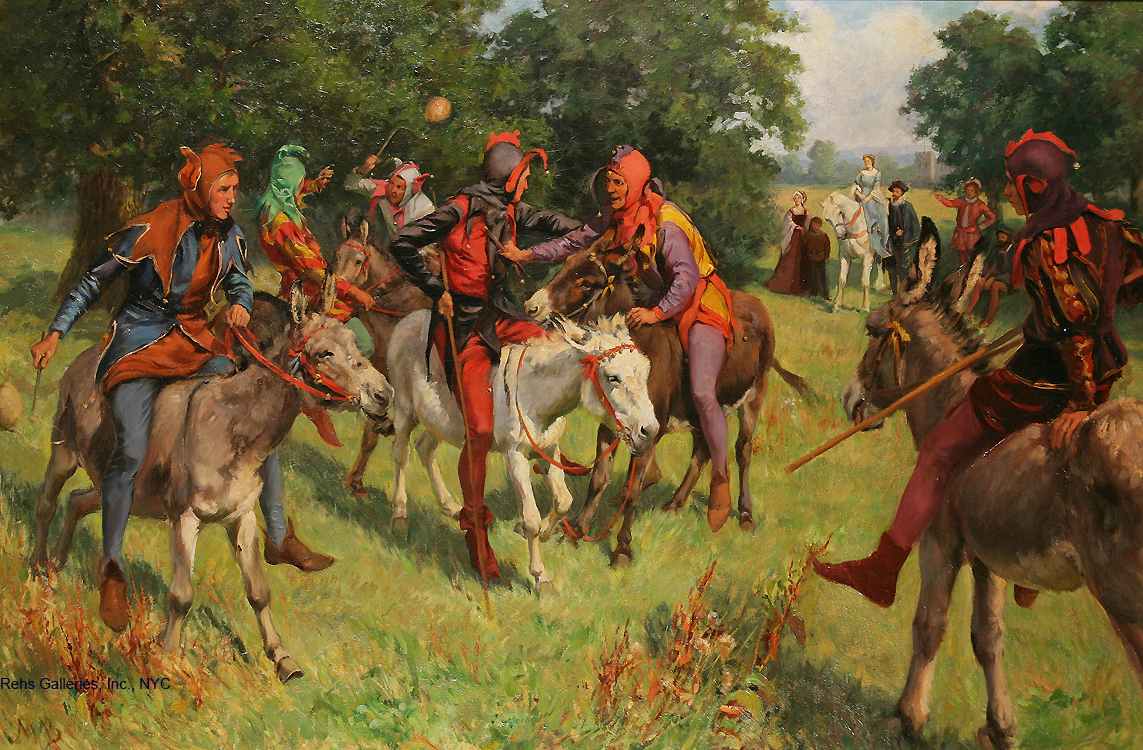That’s right. Jesters. Fools. Silly people with bells on their hats and marottes who tend to tell inappropriate jokes, make spectacles of themselves, and generally, well, act like fools. Just like the jesters in The Jester’s Joust painting by Mary Browning and The Court Jester by William Merritt Chase. The joke is that out of the 12 experts on jesters in the world, I’m number 13, but that’s only because I’ve read everything the other 12 experts have to say, so I owe it all to them.
Even though information about jesters can be scarce and hard to find, I’ve found several primary and secondary sources, and have done the usual online searches. Most of the Internet information can be repetitive and basic, which is fine if that’s all you’re looking for. If you want more details and a deeper analysis, definitely check out some of the other sources I recommend.
Information About Jesters
Since I’ve already got a good start on ground work, I’ve written a fairly comprehensive review of several of the research and scholarly works that I’ve read over jesters and fools.
I’ve also written up a shorter review of some of the fiction books I’ve read that include jesters and fools. I keep reading and adding to the list, however, so check back if you’re looking for more recommendations.
Jesters Online
There are a couple of great online sources. The general Wikipedia article over the court jester is very basic and very good, as is this discussion from a site about a real jester in New England that you can hire for performances. (Awesome!) Die Maiers are also for hire! I’m not sure if Michael Davis is. If so, he’s probably too expensive. (Because I’m sure Die Maiers are completely affordable…) Totally worth it though. He’s hilarious.
There are a couple of educational sites, and this history on HubPages is fantastic, especially in its description of where jesters came from. There’s so much more to being a jester than just fun and games.
And I’m not talking about the evil jesters from Batman comics. Or the creepy ones from tattoos and gaming sites. Or even the absolutely bonkers ones from literature. I’m going to go with the classic fool. The ones that cheer up the king, distract the general public, and generally pretend like they’re acting however they want to act, but are really calculating each and every move and maneuver. It’s fascinating.
No. Really. I swear it is.
Being a jester isn’t for everyone
No one wants to be associated with being a fool. Let’s face it, it’s got a negative connotation. Fools from history were treated like animals (made to sleep with the dogs), and some were even kept in circus cages (oh, those rascally Russian czars). This is why I prefer the title jester. (Yes, even I’m biased.) It implies a certain look–cap and bells, face paint, harlequin outfit–but also lends a little dignity to the title. As if it’s a career choice, and not something someone fell into off the back of a horse.
But even the word “fool” has deeper meaning. The whole tarot card meaning in itself is complicated (as are all tarot card meanings, of course…), but it comes down to the beginning and the end. The Major Arcana starts with the Fool and ends with the Universe (or the World), and one is influenced by the other. Yes, an end and beginning, but still a circle and the “start” of a whole new cycle.
So the fool is a social outcast, but still a necessary part of society. The entertainer and the one who makes everyone forget their troubles and laugh, but also the scapegoat–the patsy. Jesters just took that a step further and made a business out of it.
At times, it wasn’t a very well-paid business, and the risk of losing your life was high, but it was a business all the same.



2 thoughts on “Jesters and Fools. My Niche, But Not for Everyone.”